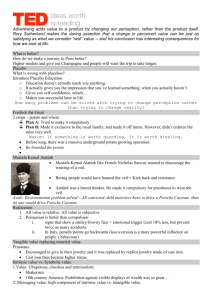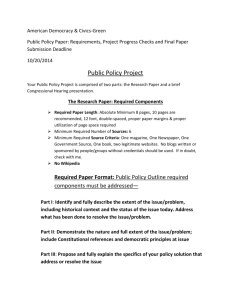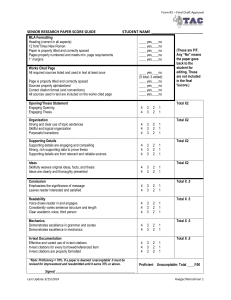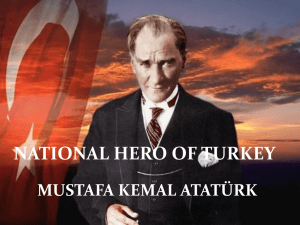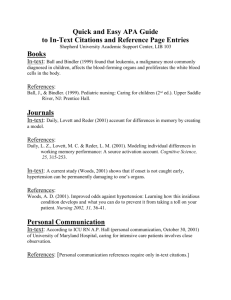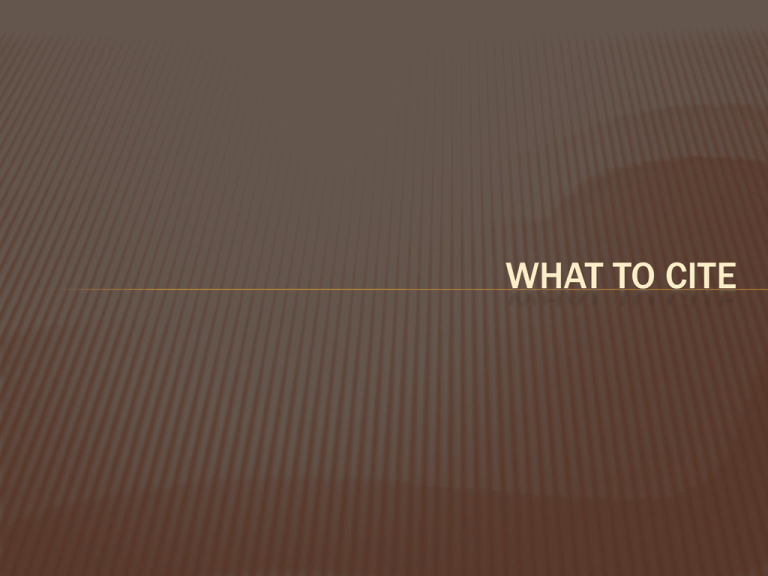
WHAT TO CITE
COMMON KNOWLEDGE
Diana died after a car crush in a road tunnel in
Paris along with Dodi Al-Fayed.
(Citation is not needed, common knowledge)
After Diana’s death, on July 6, 2004, Queen
Elizabeth II officially opened the Diana, Princess of
Wales Memorial Fountain designed by the
architect Kathryn Gustafson. The fountain is
located in Hyde Park in London.
(Citation needed, not common knowledge)
WHAT NEEDS TO BE CITED VS. WHAT IS COMMON KNOWLEDGE.
All statistics, data, figures
References to studies done by
others
References to specific facts the
avarage reader would not know
unless s/he had done research
All direct quotations
All paraphrases
All summaries
All translations
General information that most
people know. (World war I took
place between the years 19141918.)
Information shared by a cultural
group. (Atatürk was born in
Salonika in 1881.)
Knowledge shared by the members
of a certain field. The leaderMember-Exchange Theory in
political science describes how
leaders, over time, develop
different exchange relationships
with their various followers)
RELATIVITY
What is common knowledge in one culture, to
one group, might not be common in another.
EVEN IF A PIECE OF INFORMATION IS COMMON
KNOWLEDGE, YOU NEED TO CITE IT IF YOU HAVE
TAKEN IT FROM A BOOK/ARTICLE ETC. !
WHEN IN DOUBT, CITE IT!
COMMON KNOWLEDGE OR NOT?
1.
76 % of the American men sent to Vietnam were from the lowermiddle, working class backgrounds.
2.
Barrack Obama is the first elected African-American president of
the USA.
3.
Hitler was born in 20 April 1889 at the Gasthof zum Pommer.
4.
The 1789 French Revolution was a period of political and social
upheaval in the history of France during which the French
government underwent radical changes.
COMMON KNOWLEDGE OR NOT?
1.
76 % of the American men sent to Vietnam were from the lower-middle,
working class backgrounds. (Not common knowledge-cite it)
2.
Barrack Obama is the first elected African-American president of the USA.
(Common knowledge)
3.
Hitler was born in 20 April 1889 at the Gasthof zum Pommer. (Not
common knowledge-cite it)
4.
The 1789 French Revolution was a period of political and social upheaval
in the history of France during which the French government underwent
radical changes. (Common knowledge)
APA STYLE CITATION
Giving in-text and end-text references
(Surname, year, page number)
IN-TEXT CITATION
THREE WAYS
Gawrich (1988) refers to an incident during the
Dardanelles Campaign. He narrates that
Mustafa Kemal...in that area (p.322)
Robinson (1963, p. 245) explains that during
the battle of Anafarta Ridge, ...little hope of
survival.
In Leadership: Enriching the Lessons of
Experience, it is argued that... (Hughes, Ginnett
& Curphy, 2006, p. 290).
TASK: GO BACK TO THE TEXT «MUSTAFA KEMAL ATATÜRK: A COMMANDER AND
AN EFFECTIVE LEADER». FIND AND UNDERLINE EXAMPLES FOR EACH OF THE
REFERENCES ABOVE.
DIFFERENT CASES OF IN-TEXT CITATIONS
DIFFERENT CASES OF IN-TEXT CITATIONS
1.
2.
A source with 2 writers:
Programs for helping leaders and would-be
leaders to become more emotionally intelligent
have mushroomed in recent years. (Hermen &
Mellers, 2000, p. 32)
Hermen and Mellers (2000) state that programs
for helping leaders and would-be leaders to
become more emotionally intelligent have
mushroomed in recent years (p.32).
A SOURCE WITH 3+ WRITERS
The first time it is mentioned:
In leadership: enhancing the Lessons of Experience, it is argued that leaders
can be distinguished by their vision and values (Hughes, Ginnet, & Curphy,
2006, p.34).
From the second time onwards:
Once a leader displays a particular full range leadership behavior, followers
react in a way that either motivates or demotivates them (Hughes et al., 2006,
p. 34).
Hughes et al. (2006, p.34) explain that once a leader displays a particular full
range leadership behaviour, followers react in a way that either motivates or
demotivates them.
A BORROWED SOURCE IN THE SOURCE
According to Viscount Slim, willpower and
firmness, which are elements of determination,
are the most critical characteristics for a leader
(as cited in Hughes et al., 2006, p. 15).
NO AUTHOR
If the source you use has no author but is the work of
an organization, you can give the name of the
organization instead of the writer’s surname.
(UNESCO, 1999, para. 4)
If the source you use has no author, give the title in
quotation marks.
(“An Effective Leader,” 2000, para. 7)
NO DATE
If there is no date of publication, put “n.d.” in the
place of year of publication.
(Jackson, n.d., para.5).
ABOUT PAGE NUMBERS
If the information is on a single page, put “p.” before the page
number.
Lewis (1967) points out that following his victory in the Turkish
War of Independence, there were many distractions, which at
that time might have dissuaded Mustafa Kemal, a war-hero (p.
254).
If the information is on more than a single page, put “pp.” before
and “-“ between the page numbers.
Kinross (1965, pp. 94-95) points out that knowing the patriotic
fighting spirit of the Turks, Mustafa Kemal knew how to arouse
Turk’s blood. This is how Mustafa Kemal and the Turkish soldiers
saved the Gallipoli Peninsula.
If there is no page number, indicate the paragraph number with either
the abbreviation “para.” or with the symbol “¶”
In his article “Atatürk in His Lifetime and Today”, Mango (2000)
explains, as one of the Turkish biographers put it, the basic ideas, the
new ideas came from Atatürk, their implementation he left to others
(para. 3).
OR
In his article “Atatürk in His Lifetime and Today”, Mango (2000)
explains, as one of the Turkish biographers put it, the basic ideas, the
new ideas came from Atatürk, their implementation he left to others
(¶ 3).
An end-text reference provides a more detailed account of the sources that have been
used in the essay. The aim of giving end-text reference is to provide the reader with all the
necessary information in case s/he wants to make use of the same source. End-text
reference is listed under the title “References” at the end of your essay.
END-TEXT CITATION
GUIDELINES
All the sources cited in the text should appear on the reference list.
The title of the reference list should be “References” and should be
centered on the page.
The reference list should begin on a new page.
The list of works should be arranged alphabetically by the authors’
surnames.
The entries should be double-spaced. The first line should be flushed
with the left margin, and all subsequent lines should be indented five
spaces from the left margin.
WHAT KIND OF SOURCES ARE LISTED IN THE REFERENCE LIST BELOW? BOOK,
JOURNAL ARTICLE, BOOK BY MORE THAN 1 AUTHOR, INTERNET ARTICLE, NEWSPAPER
ARTICLE?
REFERENCES
Gawrych, G. (1988). Kemal Ataturk’s politico-military strategy in the Turkish War of Independence
1919–1923: From guerilla warfare to the decisive battle. In S. Potter (Ed.), The Journal of Strategic
Studies (pp.320-327). New York: Routledge.
Handel, M. (1996). Masters of war: Classical strategic thought. London: Frank Cass.
Hughes, R., Ginnett, R., & Curphy, G. (2006). Leadership: Enhancing the lessons of experience (5th ed.).
Singapore: Irwin McGraw-Hill.
Kinross, L. (1965). Ataturk: The rebirth of a nation. London: Morison and Gibb Limited.
Lewis, B. (1967). The emergence of modern Turkey (2nd ed.). London: Oxford University Press.
Mango, A. (2000, September 24). Atatürk in his lifetime and today. Retrieved September 1, 2008, from
http://www.ataturksociety.org/asa/voa/mango.html
Robinson, R. (1963). The first Turkish republic: A case study in national development.
Massachusetts:Harvard University Press.
BOOK WITH ONE WRITER
As end-text reference:
Initials of the
author’s first
name
Year of
publication
City of
publication
Publisher of
the book
Ayling, S. E. (1966). Portraits of power. New York: Barnes & Nobles, Inc.
Author’s
surname
As in-text reference:
(Ayling, 1966, p. 56)
Name of
the book
BOOK WITH TWO WRITERS
As end-text reference:
Atkinson, R. H., & Longman, D. G. (2003). Power and leadership. Boston: Thomson Heinle.
As in-text reference:
(Atkinson & Longman, 2003, p. 192)
BOOK WITH 3+ WRITERS
As end-text reference:
Hughes, R. L., Ginnett, R. C., & Curphy, G. J. (2006). Leadership: Enhancing the lessons of
experience (5th ed.). Singapore: McGraw-Hill.
As in-text reference:
The first time it is mentioned: (Hughes, Ginnett, & Curphy, 2006, p. 34)
From the second time onwards: (Hughes et al., 2006, p. 34)
BOOK WITH EDITOR(S)
As end-text reference:
Burke, R. J., & Cooper, C. L. (Eds.). (2006). Inspiring leaders. New York: Routledge Tailor and
Francis Group.
As in-text reference:
(Burke & Cooper, 2006, p. 45)
CHAPTER OR ARTICLE IN A BOOK
As end-text reference:
Name of
the writer
Book’s year of
publication
Name of
the article
Names of
the book’s
editors
King, M. L. (2007). Three ways of meeting oppression. In S. Bachmann, & M. Barth (Eds.),
Between worlds: A reader, rhetoric and handbook (5th ed.). (pp. 237-240). New York:
Pearson-Longman.
Name of
the book
As in-text reference:
(King, 2007, pp. 237-238)
How many times
the book has
been edited
page
numbers of
the article
ARTICLE IN A JOURNAL
As end-text reference:
Names of
writers
Journal’s year
of publication
Name of the
article
Name of
the journal
Lewis, C., & Robinson W. (2005). The authoritarian personality. The Journal of Psychology, 40
(4), 470-501.
Issue
number of
the journal
Page
number of
the article
As in-text reference:
(Lewis & Robinson, 2005, p. 471)
Volume
number of the
journal
INTERNET ARTICLE
As end-text reference:
Author’s
surname
Date of
publication
/Release on the
Web
Name of
the article
Date when the
article was
accessed
Mango, A. (2000, September 24). Atatürk in his lifetime and today. Retrieved September 1,
2008, from http://www.ataturksociety.org/asa/voa/mango.html
As in-text reference:
(Mango, 2000, para. 3)
Web address of
the site where the
article was found
INTERNET ARTICLE WITH NO DATE
As end-text reference:
McGrath, T. (n.d.). Is war inevitable?. Retrieved May 23, 2008, from
http://www.phillymag.com/articles/is_war_inevitable/ page3
As in-text reference:
(McGrath, n.d., para. 5)
Appendix B-5
TASK

